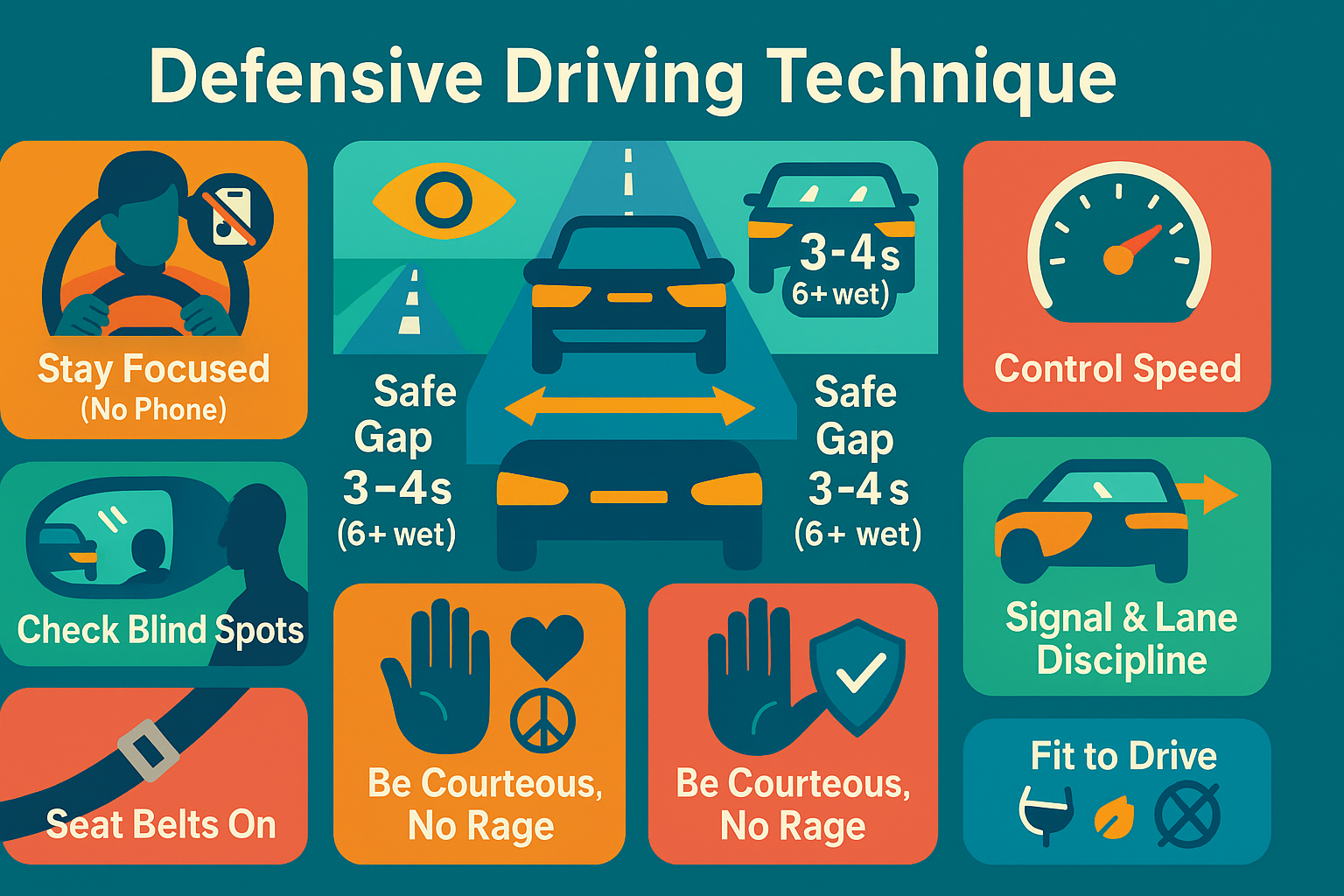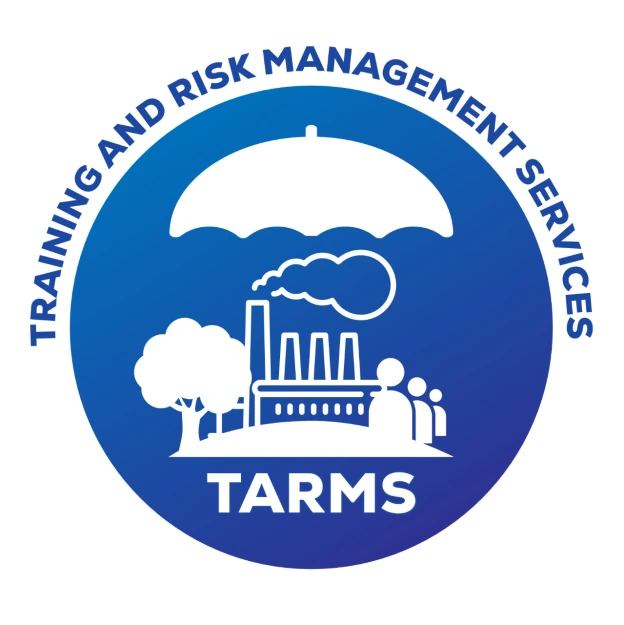Background
Defensive driving is a proactive approach that prevents crashes by anticipating hazards, managing speed and space, and communicating clearly with other road users. It supports legal compliance and ISO 45001 by strengthening hazard identification, operational controls, competence, and continual improvement.
Definition
Defensive driving: The intentional use of observation, anticipation, communication, and speed–space management to prevent collisions caused by driver error, other road users, vehicle condition, or environment.

11 Core Techniques (Why • How • Measure)
1. Stay focused; avoid distractions
Why it matters: Inattention delays hazard detection and lengthens reaction time.
How to apply:
- Set phone to Do‑Not‑Disturb; no calls/messages while moving.
- Secure tools, documents, and devices before departure.
- Keep eyes and mind on driving tasks only.
Measure (KPI): 0 handheld‑phone incidents; cab audits; telematics distraction flags.
2. Scan ahead and anticipate hazards
Why it matters: Early detection creates time and space to choose safer options.
How to apply:
- Maintain ~12‑second visual lead; extend on highways.
- Mirror check every 5–8 seconds; scan intersections early.
- Read risky cues: erratic motorcycles, doors about to open, parked vehicles with drivers inside.
Measure (KPI): Higher coaching scores for scanning; fewer hard‑brake events.
3. Maintain a safe distance
Why it matters: Stopping distance depends on speed, vehicle mass, road, and human reaction time.
How to apply:
- Light vehicles: 3–4 seconds in dry, 6+ in rain/fog.
- Heavy or loaded vehicles: add 1–2 seconds.
- Increase gap at night and around buses/motorcycles.
Measure (KPI): Telematics tailgating alerts trending to zero.
4. Manage speed for conditions (steady; slow in bad weather)
Why it matters: Higher speed multiplies crash energy and reduces decision time.
How to apply:
- Obey limits and fleet speed caps.
- Reduce speed early for rain, fog, gravel, speed breakers, work zones, animals.
- Keep a steady pace; avoid harsh accel/braking.
Measure (KPI): Overspeed minutes per 100 km down; fewer harsh events; better fuel economy.
5. Check blind spots; avoid others’ blind spots
Why it matters: Side‑swipes and turn conflicts often occur in blind zones.
How to apply:
- Mirror‑signal‑shoulder check before lateral moves.
- Do not linger beside trucks/buses; pass promptly and safely.
- Set mirrors correctly at each shift start.
Measure (KPI): Zero side‑swipe incidents; coaching observations.
6. Limit unnecessary lane changes
Why it matters: Each lane change adds conflict points and risk.
How to apply:
- Plan positioning early for turns/exits.
- Hold lane unless passing safely is necessary.
- Avoid weaving in congestion.
Measure (KPI): Lower lane‑change counts on telematics; fewer near misses.
7. Always signal your intentions
Why it matters: Clear communication reduces surprises for others.
How to apply:
- Signal 3–5 seconds before lane changes/turns.
- Use hazard lights only for genuine hazards or when stationary in unsafe locations.
- Make eye contact with vulnerable road users when possible.
Measure (KPI): Field observations and dash‑cam reviews show timely signalling.
8. Follow traffic laws and signs
Why it matters: Compliance is the baseline for predictable, safe behavior.
How to apply:
- Full stops at stop lines; respect zebra crossings/school zones.
- Obey one‑way, no‑U‑turn, and work‑zone controls.
- Respect right of way and traffic police directions.
Measure (KPI): Zero traffic tickets; root causes show no rule breaches.
9. Be courteous and predictable; avoid aggressive driving / road rage
Why it matters: Aggression escalates conflict and triggers errors in others.
How to apply:
- Stay calm; yield when safe; avoid tailgating/horn abuse.
- Do not compete with reckless drivers; create space and let them go.
- Use de‑escalation scripts and report hostile incidents.
Measure (KPI): Public complaint rate near zero; no harsh‑driving clusters.
10. Wear seat belts correctly
Why it matters: Seat belts cut fatal/serious injury risk significantly.
How to apply:
- Belt all occupants before moving; lap low across hips; shoulder across chest.
- Never place belt under the arm; use approved child restraints for minors.
Measure (KPI): 100% belt compliance in spot checks and dash‑cam audits.
11. Be fit to drive (rested, sober, meds / vision checked)
Why it matters: Fatigue, alcohol, drugs, illness, and poor vision degrade performance.
How to apply:
- Follow planned rest breaks; stop if drowsy.
- Zero tolerance for alcohol/impairing drugs.
- Declare impairing medication; complete periodic eyesight checks.
Measure (KPI): Fit‑to‑drive declarations; fewer fatigue events; medical compliance logs.
Implementation & ISO 45001 Anchors
- Pre‑trip routine: vehicle condition, mirrors, seat, belt, route, weather, and phone on DND.
- Coaching: in‑cab observation using a standard checklist aligned to the 11 elements.
- Telematics: monitor overspeed, harsh events, tailgating, and distraction proxies.
- KPIs: collisions and near misses per 100,000 km; compliance audit scores; fuel and brake wear trends.
- ISO 45001 clauses: 6.1 (hazard ID), 7.2 (competence), 8.1 (operational control), 8.2 (emergency preparedness), 9.1 (monitoring), 10.2 (improvement).

